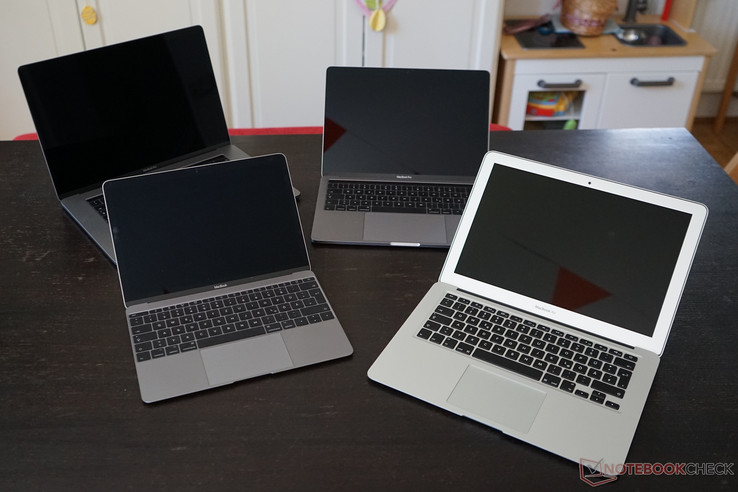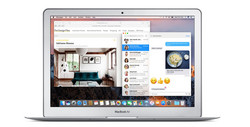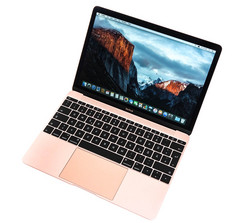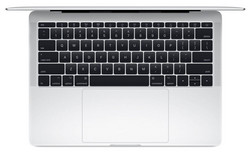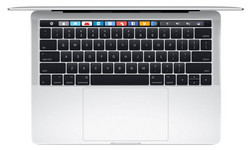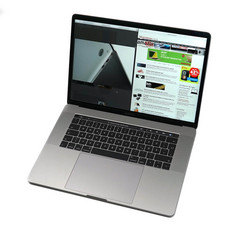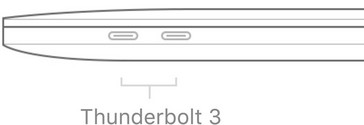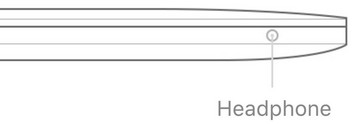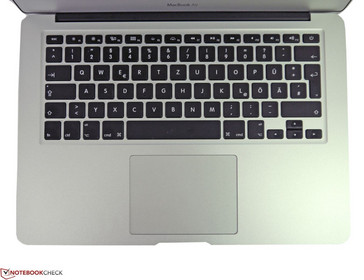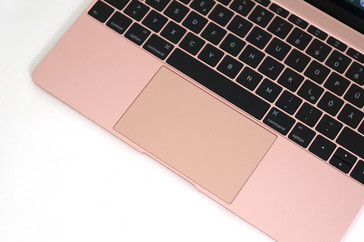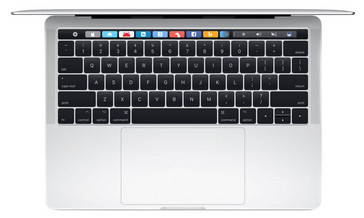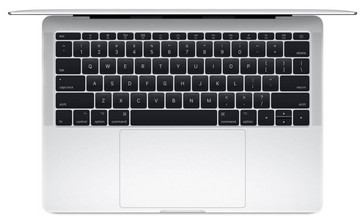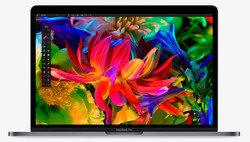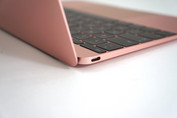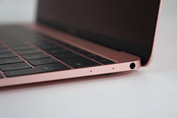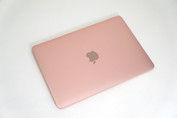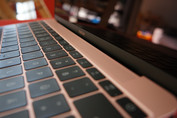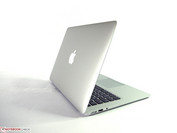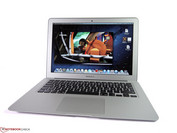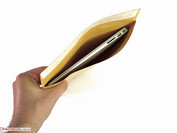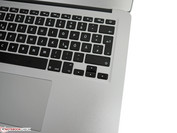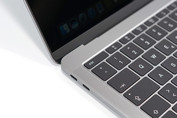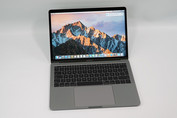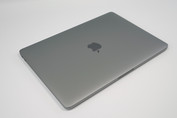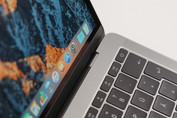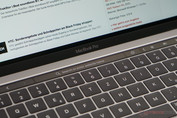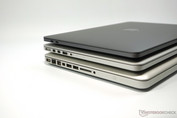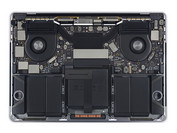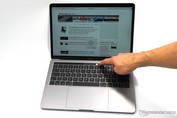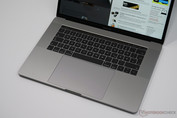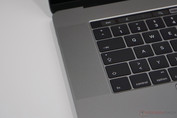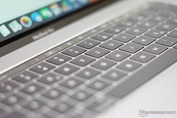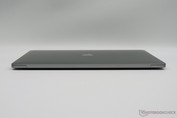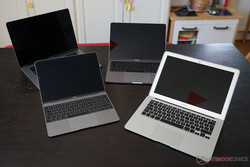Buyer's Guide: Which MacBook is right for me?
Further details can be found in our extensive reviews of each individual model: MacBook 12 2017, MacBook 13 Air 2017, MacBook Pro 13 Touch Bar, and MacBook Pro 15.
Apple's MacBook Family
For the original German article, see here.
MacBook Air: When it was first introduced, the MacBook Air pretty much single-handedly started the Ultrabook revolution. However, it has aged quite noticeably in the recent years, and its low 1440x900 display resolution makes this painfully obvious. Despite the fact that Apple has upgraded the MacBook Air somewhat during this year’s WWDC17, it was only a very minor upgrade: CPU speed has been bumped by 100 MHz, but at its core, it is still a Broadwell processor first released in 2015. Price range: $999 to $1549.
MacBook: Back in 2010, the entry-level MacBook that used to be the most affordable way to enter the Apple universe has been discontinued. Its reincarnation, however, is very different from what it used to be – elegant, slim, tiny, and even more portable than before. By reducing its connectivity to a bare minimum (two ports total), Apple has reinvented the MacBook. The new model is aimed at those customers for whom portability is the highest commodity in a notebook, and who limit themselves to mostly browsing the web (aka working online) and word processing.
Depending on the configuration, the MacBook can be more expensive than the MacBook Pro. The base model starts at $1299 while the fully equipped MacBook sells for $1949.
MacBook Pro 13 (no Touch Bar): At a first glance, the difference between the model with and without a Touch Bar is obvious: the latter lacks the Touch Bar. However, the differences do not stop there because the MacBook Pro 13 without Touch Bar is also equipped with a slower CPU and GPU combo. Price range: $1299 to $2599.
MacBook Pro 13 Touch Bar: The happy medium. The 13-inch Touch Bar model is the essence of the MacBook series. It is almost as portable as the MacBook, but a lot faster. Depending on the configuration, it can be had for as little as $1799 or as much as $2899.
MacBook Pro 15 Touch Bar: Big and powerful! Thanks to quad-core CPUs and dedicated graphics, the 15-inch MacBook Pro is Apple’s flagship notebook. The most powerful Apple notebook is aimed at customers who either own only one computer, or those who need a portable powerful companion. Unfortunately, the 15-inch device is very expensive – it starts at $2399 and goes all the way up to $4199.
Case: Unibody Aluminum for all MacBooks
All MacBooks feature a high-quality unibody aluminum case. Unlike in the olden days, the MacBook Air is no longer the slimmest Apple notebook. In fact, since all other available models are slimmer than the Air, it has become the chubby one.
The MacBook is available in four different colors: space grey, gold, rose gold, and silver. Only two of those are available for the Pro: space grey and silver. And the Air is only available in silver. It is also the only remaining Apple notebook with the familiar illuminated white Apple logo on its lid.
Not only has the MacBook Air been surpassed by its more modern siblings in terms of slimness, it is also no longer the lightest Apple notebook and had to slowly but surely relinquish its top position over the years. At only 1.4 kg (~3.1 lb), the 13-inch MacBook Pro now weighs the same as the Air, and weighing in at an astonishing 920 g (~2 lb) the MacBook is by far the lightest Apple notebook on the market today.
Connectivity: Thunderbolt and USB-C All-Rounders
Over the last few generations, Apple has consistently reduced the number of available ports on its notebooks. This becomes painfully obvious in particular on the MacBook, with its single USB 3.1 Type-C port (5 Gbps) that is also used for charging, and its headphone jack. If you need more, but do not want to resort to adapters or a USB-C dock, the MacBook Pro offers between two (13-inch no Touch Bar) and four Thunderbolt ports. However, you will still need adapters in order to plug in a simple thumb drive, since only the MacBook Air has two full-sized USB Type-A ports.
Communication – Fast Wi-Fi Chips
First things first: all of Apple’s notebooks are equipped with very fast Wi-Fi modules. However, all animals are equal, but some animals are more equal than others, and the MacBook and MacBook Air are somewhat slower than the Pros. Only under more difficult conditions (several thick concrete walls between the router and the notebook) do the Air and the Pro approximate each other with the MacBook trailing slightly behind. Overall, all MacBooks are very impressive in this respect.
Input Devices – Force Touch and the Butterfly Keyboard
Except for the MacBook Air, all of Apple’s notebooks are equipped with the latest 2nd generation Butterfly keyboard known for its extremely shallow key travel and very firm and distinct feedback. That said, the MacBook’s travel is even shorter than the MacBook Pro’s. Since this surely is not going to suit everybody we highly recommend to test the keyboards in an Apple Store or other retail location before you buy one. The touchpad is very large on all models, and is by far one of the best we have ever tested. The MacBook Air still features the standard non-Force-Touch touchpad.
Display - No Retina for the Air
When reviewing the MacBook Air, we really did not have anything positive to say about its display. Mildly put, TN panels are immensely outdated at this point. Even after its latest set of upgrades, the Air’s display resolution is still stuck at 1440x900 (129 PPI), and comparing it to what Apple has to offer in the other MacBooks renders this line-up grotesque. The small 12-inch MacBook has a display resolution of 2304x1440 (226 PPI); the 13-inch MacBook Pro offers 2560x1600 (227 PPI); and the 15-inch flagship an astounding 2880x1800 (220 PPI). The Retina display’s rendering of text is much sharper and easier on the eyes. Compared to last year’s models, all MacBooks are using the exact same panels as before.
Display brightness has always been a strong point of Apple’s MacBooks: all models offer more than 300 nits, and the Pros even go the extra mile to beyond 500 nits. All displays are glossy - Apple has stopped offering a matte display option since 2010.
Impressive color and gray scale accuracy are also something that all Apple notebooks have in common. Even the Air’s TN panel offers surprisingly accurate color representation considering its display technology.
Only the Pro models offer full sRGB coverage.
Display brightness adjustment is performed via PWM. However, the frequency is so high that it is completely unnoticeable even for the most sensitive of users.
| Apple MacBook Pro 13 2017 Touchbar i5 Iris Plus Graphics 650, i5-7267U, Apple SSD AP0256 | Apple MacBook 12 2017 HD Graphics 615, m3-7Y32, Apple SSD AP0256 | Apple MacBook Pro 15 2017 (2.8 GHz, 555) Radeon Pro 555, i7-7700HQ, Apple SSD SM0256L | Apple MacBook Air 13.3" 1.8 GHz (2017) HD Graphics 6000, 5350U, Apple SSD SM0128G | Apple MacBook Pro 13 2016 Iris Graphics 540, 6360U, Apple SSD AP0256 | Apple MacBook Pro 13 2016 (2.9 GHz) Iris Graphics 550, 6267U, Apple SSD AP0256 | Apple MacBook Pro 13 2017 Iris Plus Graphics 640, i5-7360U, Apple SSD AP0128 | Apple MacBook Air 13 inch 2015-03 HD Graphics 6000, 5650U, Apple SSD SD0256F | Apple MacBook 12 (Early 2016) 1.1 GHz HD Graphics 515, 6Y30, Apple SSD AP0256 | |
|---|---|---|---|---|---|---|---|---|---|
| Display | |||||||||
| Display P3 Coverage (%) | 98.6 | 97.9 | 97.1 | 99.2 | 99.2 | 40.1 | 66.8 | ||
| sRGB Coverage (%) | 100 | 99.9 | 99.8 | 99.9 | 99.9 | 59.8 | 95.4 | ||
| AdobeRGB 1998 Coverage (%) | 86.5 | 85.9 | 86.7 | 87.6 | 87.1 | 41.51 | 68 | ||
| Response Times | |||||||||
| Response Time Grey 50% / Grey 80% * (ms) | 48 ? | 40.8 ? | 48 ? | 52.4 ? | 47.2 ? | 47.2 ? | 42.8 ? | 41.2 ? | |
| Response Time Black / White * (ms) | 33.6 ? | 29.2 ? | 33.8 ? | 28.4 ? | 51.6 ? | 53 ? | 28.8 ? | 30.4 ? | |
| PWM Frequency (Hz) | 119000 ? | 116000 | 119000 ? | 58000 | |||||
| Screen | |||||||||
| Brightness middle (cd/m²) | 551 | 545 | 600 | 569 | 588 | 329 | 387 | ||
| Brightness (cd/m²) | 514 | 523 | 564 | 542 | 561 | 310 | 358 | ||
| Brightness Distribution (%) | 88 | 86 | 89 | 90 | 92 | 82 | 88 | ||
| Black Level * (cd/m²) | 0.48 | 0.44 | 0.57 | 0.56 | 0.45 | 0.405 | 0.47 | ||
| Contrast (:1) | 1148 | 1239 | 1053 | 1016 | 1307 | 812 | 823 | ||
| Colorchecker dE 2000 * | 0.8 | 1.6 | 1.5 | 1.4 | 1.7 | 3.96 | 1.6 | ||
| Colorchecker dE 2000 max. * | 1.4 | 3.8 | 2.9 | 2.9 | 3.5 | 7.51 | 4 | ||
| Greyscale dE 2000 * | 1 | 1.9 | 2 | 1.8 | 1.9 | 3.51 | 1 | ||
| Gamma | 2.16 102% | 2.26 97% | 2.27 97% | 2.16 102% | 2.33 94% | 3.83 57% | 2.26 97% | ||
| CCT | 6672 97% | 6834 95% | 6855 95% | 6877 95% | 6738 96% | 6711 97% | 6680 97% | ||
| Color Space (Percent of AdobeRGB 1998) (%) | 77 | 78.4 | 77.92 | 38.4 | 61.6 | ||||
| Color Space (Percent of sRGB) (%) | 92 | 99.3 | 99.94 | 59.8 | 82.2 | ||||
| Total Average (Program / Settings) |
* ... smaller is better
Models and Configurations
Apple MacBook
Both models are available in all four colors (space grey, gold, rose gold, and silver). The MacBook’s CPU is a highly energy-efficient Y-model from Intel’s latest generation, and can thus be cooled passively. Watch out though: despite its name, the Intel Core i7 in the MacBook does not offer the same level of performance as its i7 namesakes. All things considered, the MacBook is fast enough for everyday use. Only prolonged load can cause the CPU to throttle due to its passive cooling solution.
| SKU 1 | SKU 2 | |
|---|---|---|
| Processor: | 1,2 GHz Intel Core m3-7Y32 | |
| or 1,3 GHz Intel Core i5-7Y54 (+ $100) | or 1,3 GHz Intel Core i5-7Y54 | |
| or 1,4 GHz Intel Core i7-7Y75 (+ $250) | or 1,4 GHz Intel Core i7-7Y75 (+ $150) | |
| GPU | Intel HD Graphics 615 | Intel HD Graphics 615 |
| RAM | 8 GB 1866 MHz LPDDR3 SDRAM | 8 GB 1866 MHz LPDDR3 SDRAM |
| or 16 GB 1866 MHz LPDDR3 SDRAM (+ $200) | or 16 GB 1866 MHz LPDDR3 SDRAM (+ $200) | |
| Storage | 256 GB SSD | 512 GB SSD |
| Price: | $1299 | $1599 |
In Cinebench R15, the Core m3 CPU sometimes manages to beat the supposedly faster i5/i7 processors, as our benchmark list shows. On the other hand, the i7 CPU performed 40 % faster than the m3 in the Cloud Gate benchmark (physics).
In terms of storage, it is important to note that the Core m3 model is only available with up to 256 GB of storage. If you need more than that, the second model with Core i5-7Y54 and a 512 GB SSD for an additional $300 offers just that.
Unlike the Pro, the MacBook supports only USB 3.1 Type-C on its single port, which is used for data transfer as well as charging. Using external hard drives has thus been rendered unnecessarily complicated. We have had the m3-powered MacBook 12 in review.
Apple MacBook Air:
The possibilities of configuring a MacBook Air to your liking are much fewer than for the MacBook. Only two different processors and three storage tiers can be chosen from, and the RAM is fixed at 8 GB. The 11-inch model is no longer available.
| SKU 1 | SKU 2 | |
|---|---|---|
| Processor | 1,8 GHz Intel Core i5-5350U | 1,8 GHz Intel Core i5-5350U |
| or 2,2 GHz Intel Core i7-5650U (+ $150) | or 2,2 GHz Intel Core i7-5650U (+ $150) | |
| GPU | Intel HD Graphics 6000 | Intel HD Graphics 6000 |
| RAM | 8 GB 1600 MHz LPDDR3 | 8 GB 1600 MHz LPDDR3 |
| Storage | 128 GB SSD | |
| or 256 GB SSD (+ $200) | 256 GB SSD | |
| or 512 GB SSD (+ $400) | or 512 GB SSD (+ $200 Euro) | |
| Price | $999 | $1199 |
And no, we did not accidentally list an older 2015 MacBook Air; the Air is just that old. And while it outperforms the 12-inch MacBook, the formerly slimmest notebook in the world does so with an active cooling solution. The MacBook Air is aimed at those users, who are looking for an “affordable” notebook running macOS. The performance difference between the two CPUs is around 5 to 10%.
Apple MacBook Pro 13 (no Touch Bar):
The no-Touch-Bar model of Apple’s 13-inch Pro line-up requires particular attention in terms of CPU configuration. The faster i7 version is clocked 400 MHz higher than the i5, which makes it between 5 to 10% faster. The lack of a Touch Bar strip on the keyboard has its perks, too: as we were able to discover during our review, the MacBook Pro 13 (no Touch Bar) offers a superior battery life.
| SKU 1 | SKU 2 | |
|---|---|---|
| Processor | 2,3 GHz Intel Core i5-7360U | 2,3 GHz Intel Core i5-7360U |
| or 2,5 GHz Intel Core i7-7660U (+ $300) | or 2,5 GHz Intel Core i7-7660U (+ $300) | |
| GPU | Intel Iris Plus Graphics 640 | Intel Iris Plus Graphics 640 |
| RAM | 8 GB 2.133 MHz LPDDR3 | 8 GB 2.133 MHz LPDDR3 |
| or 16 GB 2.133 MHz LPDDR3 (+ $200) | or 16 GB 2.133 MHz LPDDR3 (+ $200) | |
| Storage | 128 GB SSD | |
| or 256 GB SSD (+ $200) | 256 GB SSD | |
| or 512 GB SSD (+ $400) | or 512 GB SSD (+ $200) | |
| or 1 TB SSD (+ $800) | or 1 TB SSD (+ $600) | |
| Price | $1299 | $1499 |
As mentioned already in the introduction, the non-Touch-Bar model is equipped with slower processors than the Touch Bar model. The non-Touch-Bar’s faster Core i7-7660U CPU offers roughly the same performance as the Touch Bar’s midrange Core i5-7287U CPU. Compared to the MacBook and the MacBook Air, the MacBook Pro 13 (no Touch Bar) is between 10 and 50% faster and thus aimed at users who either need more performance, or even want to use the MacBook Pro as their main computer.
Apple MacBook Pro 13 (Touch Bar):
In our most recent review of the 13-inch MacBook Pro (Touch Bar), we took a closer look at the entry-level model equipped with a Core i5-7267U, 8 GB of RAM, and a 256 GB SSD. From Apple’s point of view, this model is striking a happy medium trying to appease various demands from all over the user spectrum. The various CPU and GPU clock speeds result in a difference of 5 to 10%. If, for example, you are looking for a compact Apple notebook with as much GPU power as possible, the i7 model is the right choice. All other users will probably do just as well with the low-end or midrange configuration.
| SKU 1 | Model 2 | ||
|---|---|---|---|
| Processor | 3,1 GHz Intel Core i5-7267U | 3,1 GHz Intel Core i5-7267U | |
| or 3,3 GHz Intel Core i5-7287U (+ $100) |
| ||
| or 3,5 GHz Intel Core i7-7567U (+ $300) | or 3,5 GHz Intel Core i7-7567U (+ $300) | ||
| GPU | Intel Iris Plus Graphics 650 | Intel Iris Plus Graphics 650 | |
| RAM | 8 GB 2.133 MHz LPDDR3 | 8 GB 2.133 MHz LPDDR3 | |
| or 16 GB 2.133 MHz LPDDR3 (+ $200) | or 16 GB 2.133 MHz LPDDR3 (+ $200) | ||
| Storage | 256 GB SSD | ||
| or 512 GB SSD (+ $200) | 512 GB SSD | ||
| or 1 TB SSD (+ $600) | or 1 TB SSD (+ $400) | ||
| Price | $1799 | $1999 |
Overall, the MacBook Pro 13 (Touch Bar) is an all-round carefree package offering decent performance for even the most demanding software, and an improved graphics performance over the non-Touch-Bar model.
Apple MacBook Pro 15
The most powerful MacBook. Even the cheapest entry-level model will set you back a mind-boggling $2,400. We’ve reviewed this particular low-end model, made by Apple to be a portable workstation. In order to achieve that, Apple equips all its 15-inch MacBook Pros with Core i7 quad-core CPUs, 16 GB of RAM, and fast SSDs with at least 256 GB of storage.
| SKU 1 | SKU 2 | |
|---|---|---|
| Processor | 2,8 GHz Intel Core i7-7700HQ | 2,9 GHz Intel Core i7-7820HQ |
| or 3,1 GHz Intel Core i7-7920HQ (+$300) | or 3,1 GHz Intel Core i7-7920HQ (+$200) | |
| GPU | AMD Radeon Pro 555 mit 2 GB Speicher | |
| or AMD Radeon Pro 560 mit 4 GB Speicher (+ $100) | or AMD Radeon Pro 560 mit 4 GB Speicher | |
| RAM | 16 GB 2.133 MHz LPDDR3 | 16 GB 2.133 MHz LPDDR3 |
| Storage | 256 GB SSD-Speicher | |
| or 512 GB SSD-Speicher (+ $200) | ||
| or 1 TB SSD-Speicher (+ $600) | or 1 TB SSD-Speicher (+ $400) | |
| or 2 TB SSD-Speicher (+ $1,400) | or 2 TB SSD-Speicher (+ $1,200) | |
| Price | $2,399 | $2,799 |
The MacBook Pro 15 is geared towards those of us who need ultimate desktop processing power on the go for demanding applications such as rendering, music and video production, or general photo editing. Gamers will cringe at the prospect of an AMD Radeon Pro 560, and are better off with the likes of a Razer Blade with Nvidia GeForce GTX 1060.
Performance – More Power thanks to Kaby Lake
No matter which MacBook we have reviewed, all models are sufficiently fast for smooth everyday operations. Obviously, demanding software runs much better on the Pro series, and even between the separate Pro models there are significant differences between the 13 and the 15-inch model. For example: the MacBook Pro 15 is 90% faster in Cinebench R15 when compared to the fastest MacBook Pro 13 (Touch Bar) thanks to its quad-core processor. Accordingly, software that supports quad-core CPUs will run much faster on the 15-inch model.
Another observation worth noting is that overall, the MacBook Air is faster than the passively cooled 12-inch MacBook, particularly under prolonged load. The MacBook is incapable of maintaining its high initial performance over long periods of time. Given that the Air has a fan, it is much less susceptible to high load.
Our benchmark list of all current CPUs will help you to determine which CPU is right for you.
System Performance
It is all in the mix. Thanks to fast SSDs and dual-channel memory configurations, all MacBooks offer a very decent system performance. Fears have been raised that the MacBook’s less potent hardware combined with its high display resolution might be overwhelmed in multitasking scenarios, but we can assure you it handles these situations just fine.
Storage Devices – PCIe-based SSDs
All Apple’s notebooks are equipped with fast PCIe-based SSD storage thanks to which they are snappy and smooth in everyday operations. The SSD is soldered onto the motherboard on all MacBooks except for the MacBook Air and the MacBook Pro 13 (no Touch Bar). However, this does not mean that the latter two are easily upgraded: Apple uses a proprietary PCIe format and connector that is incompatible with the more common M.2 standard.
| Apple MacBook 12 2017 HD Graphics 615, m3-7Y32, Apple SSD AP0256 | Apple MacBook Pro 13 2017 Touchbar i5 Iris Plus Graphics 650, i5-7267U, Apple SSD AP0256 | Apple MacBook Pro 15 2017 (2.8 GHz, 555) Radeon Pro 555, i7-7700HQ, Apple SSD SM0256L | Apple MacBook Air 13.3" 1.8 GHz (2017) HD Graphics 6000, 5350U, Apple SSD SM0128G | |
|---|---|---|---|---|
| CrystalDiskMark 3.0 | ||||
| Read Seq (MB/s) | 955 | 1540 | 1557 | 1390 |
| Write Seq (MB/s) | 899 | 1353 | 1505 | 731 |
| Read 4k (MB/s) | 9.721 | 9.92 | 10.76 | 16.29 |
| Write 4k (MB/s) | 12.78 | 10.74 | 12.87 | 27.17 |
| Read 4k QD32 (MB/s) | 521 | 618 | 631 | 300.9 |
| Write 4k QD32 (MB/s) | 370.1 | 403.8 | 468.4 | 273.7 |
| Read 512 (MB/s) | 658 | 926 | 968 | 899 |
| Write 512 (MB/s) | 579 | 698 | 1124 | 715 |
Graphics Card – Integrated or Dedicated GPU
Except for the 15-inch MacBook Pro, all MacBooks are equipped with an integrated GPU only; the slowest of them all being the 12-inch MacBook followed by the 20% faster MacBook Air. The MacBook Pro 13 (Touch Bar) offers a 20 to 30% higher GPU performance than the non-Touch-Bar model thanks to its faster Iris HD 650 graphics card. However, none of these can compete with the 15-inch MacBook Pro with a dedicated GPU: with more than 120% higher scores it is more than twice as fast as the fastest 13-inch MacBook Pro in 3DMark Fire Strike.
The question is who would really need the dedicated GPU, and for whom would the integrated one suffice? For regular office use and web browsing, the integrated GPU is more than fast enough. Even light photo editing is no problem as long as the material is not too complex. A dedicated GPU is the better choice for professional use and more complex usage scenarios, such as rendering, CAD, or RAW photo editing.
For more information, check out our benchmark list of all current notebook GPUs.
| 3DMark - 1920x1080 Fire Strike Graphics | |
| Apple MacBook Pro 15 2017 (2.8 GHz, 555) | |
| Apple MacBook Pro 13 2017 Touchbar i5 | |
| Apple MacBook Pro 13 2017 | |
| Dell XPS 13 9360 FHD i7 Iris | |
Gaming Performance – For Casual Gamers Only.
If you are looking for a gaming device, an Apple notebook is definitely not the right choice. Even though the 15-inch MacBook Pro is equipped with a dedicated GPU, the price-performance ratio in terms of gaming potential is awful. Our MacBook Pro 15 only barely managed to smoothly run the games we threw at it on medium settings.
Thanks to its higher clock speed and more memory, the faster AMD Radeon Pro 560 scored better overall, and turned out to be slightly worse than a GTX 1050 but better than a GTX 1030. The slower Radeon Pro 555 is about as fast as a GeForce GTX 950M. The difference between the two AMD chips is therefore negligible.
One thing we look forward to is the developer support for external GPUs that Apple has announced during this year’s WWDC. Whether or not the end users will benefit as well, is yet to be determined.
| BioShock Infinite | |
| 1280x720 Very Low Preset | |
| Apple MacBook Pro 13 2017 Touchbar i5 | |
| Apple MacBook Air 13.3" 1.8 GHz (2017) | |
| Dell XPS 13 9365-4537 2-in-1 | |
| 1366x768 Medium Preset | |
| Apple MacBook Pro 13 2017 Touchbar i5 | |
| Apple MacBook Air 13.3" 1.8 GHz (2017) | |
| Dell XPS 13 9365-4537 2-in-1 | |
| 1366x768 High Preset | |
| Gigabyte Sabre 15G | |
| Apple MacBook Pro 13 2017 Touchbar i5 | |
| Dell XPS 13 9365-4537 2-in-1 | |
| 1920x1080 Ultra Preset, DX11 (DDOF) | |
| Gigabyte Sabre 15G | |
| Apple MacBook Pro 15 2017 (2.8 GHz, 555) | |
| Apple MacBook Pro 13 2017 Touchbar i5 | |
| Dell XPS 13 9365-4537 2-in-1 | |
| The Witcher 3 - 1920x1080 High Graphics & Postprocessing (Nvidia HairWorks Off) | |
| Gigabyte Sabre 15G | |
| Apple MacBook Pro 15 2017 (2.8 GHz, 555) | |
Emissions – Active vs. Passive Cooling
System Noise
With the exception of the 12-inch model, all MacBooks are actively cooled. However, they are almost notoriously famous for being practically silent in low-load scenarios, such as browsing the web or office work. Only on the 15-inch model are both fans running continuously.
| Apple MacBook Pro 13 2017 Touchbar i5 Iris Plus Graphics 650, i5-7267U, Apple SSD AP0256 | Apple MacBook Pro 15 2017 (2.8 GHz, 555) Radeon Pro 555, i7-7700HQ, Apple SSD SM0256L | Apple MacBook Air 13 inch 2015-03 HD Graphics 6000, 5650U, Apple SSD SD0256F | Apple MacBook Pro 13 2017 Iris Plus Graphics 640, i5-7360U, Apple SSD AP0128 | |
|---|---|---|---|---|
| Noise | ||||
| off / environment * (dB) | 30.6 | 30.9 | 30.2 | |
| Idle Minimum * (dB) | 30.6 | 31.3 | 29.2 | 30.2 |
| Idle Average * (dB) | 30.6 | 31.3 | 29.2 | 30.2 |
| Idle Maximum * (dB) | 30.6 | 31.7 | 29.2 | 30.2 |
| Load Average * (dB) | 41.8 | 39.7 | 40.2 | 32.9 |
| Witcher 3 ultra * (dB) | 39.1 | 35.5 | ||
| Load Maximum * (dB) | 41.8 | 48.6 | 46.3 | 39.3 |
* ... smaller is better
Temperature
In aforementioned low-load scenarios all MacBooks stayed comparatively cool. Under load, surface temperatures increased up to 44 °C (~111 °F) but fortunately, the palm rests remained pretty cool. Watch out for the chargers though: they can reach up to 50 °C (~122 °F) and should never be covered by pillows or blankets.
| Apple MacBook Pro 13 2017 Touchbar i5 Iris Plus Graphics 650, i5-7267U, Apple SSD AP0256 | Apple MacBook Air 13.3" 1.8 GHz (2017) HD Graphics 6000, 5350U, Apple SSD SM0128G | Apple MacBook Pro 15 2017 (2.8 GHz, 555) Radeon Pro 555, i7-7700HQ, Apple SSD SM0256L | Apple MacBook 12 2017 HD Graphics 615, m3-7Y32, Apple SSD AP0256 | Apple MacBook Pro 13 2017 Iris Plus Graphics 640, i5-7360U, Apple SSD AP0128 | |
|---|---|---|---|---|---|
| Heat | |||||
| Maximum Upper Side * (°C) | 43 | 42.8 | 44 | 38.9 | 43.5 |
| Maximum Bottom * (°C) | 39 | 41.5 | 41 | 42.5 | 40.6 |
| Idle Upper Side * (°C) | 25 | 27.6 | 24 | 30.6 | 27 |
| Idle Bottom * (°C) | 24 | 26.9 | 24 | 30.8 | 26.1 |
* ... smaller is better
Speakers
Generally speaking, all MacBooks have left a positive impression in terms of sound quality, as can be seen in the almost linear progression of our frequency diagram below. This is particularly impressive considering their dimensions. Slightly more bass and highs would have rendered the sound scape perfect.
Energy Management – Legendary MacBook Stamina
Power Consumption
Power consumption is graded into three groups, with the 12-inch MacBook and the Air at one end (2 to 7 W when idle) and the 15-inch Pro at the other (3.4 to 17.6 W). The differences are even more pronounced under maximum load: while the 12-inch MacBook stays at around 20 to 22 W, the Air requires twice as much power, the 13-inch Pro another 18 W more than the Air, and the 15-inch Pro between 71.1 and 88.5 W due to its dedicated GPU.
Battery Life
Battery life has always been Apple’s strong point, and the new models do not disappoint either. With more than eight hours, the 13-inch MacBook Pro (Touch Bar) is the first one to give in. Surprisingly enough, it is not the 12-inch MacBook that lasts the longest, but the Air: its battery died after an impressive 11.5 hours. What surprised us even more was the Pros’ stamina – clearly, Apple has refused to sacrifice mobility for performance, and accordingly the 15-inch model lasted more than 10.5 hours in our Wi-Fi test.
| Apple MacBook Pro 15 2017 (2.8 GHz, 555) Radeon Pro 555, i7-7700HQ, Apple SSD SM0256L | Apple MacBook Air 13.3" 1.8 GHz (2017) HD Graphics 6000, 5350U, Apple SSD SM0128G | Apple MacBook Pro 13 2017 Touchbar i5 Iris Plus Graphics 650, i5-7267U, Apple SSD AP0256 | Apple MacBook 12 2017 HD Graphics 615, m3-7Y32, Apple SSD AP0256 | Apple MacBook Pro 13 2017 Iris Plus Graphics 640, i5-7360U, Apple SSD AP0128 | |
|---|---|---|---|---|---|
| Battery Runtime | |||||
| WiFi Websurfing (h) | 10.7 | 10.6 | 8.7 | 9 | 11.4 |
Verdict - Finding the right MacBook
A MacBook for everyone. While Apple offers five different MacBooks that look very much alike, they do differ significantly from one another.
Let us start with the cheapest entry-level model: the MacBook Air. Largely untouched since 2008 in terms of design, the Air has seemingly fallen into oblivion in the past few years. The low-resolution TN panel is particularly disconcerting. But even though its hardware is several years old, the Air still manages to outperform the brand-new 12-inch MacBook. It is also the only Apple notebook with standard USB Type-A ports left. Thus, the Air is interesting for those who would like to get a glimpse into Apple’s universe without spending too much money.
The standard MacBook, formerly the most affordable model in Apple’s notebook line-up, is now at least $300 more expensive than the Air. Thanks to its 12-inch display, the passively cooled MacBook is the slimmest and smallest Apple notebook on the market today. Its hardware is powerful enough for everyday applications, but does not have what it takes when it comes to more demanding tasks. In addition, one has to consider the fact that besides the headphone jack the MacBook features only a single USB Type-C port that is also used for charging. Nevertheless, the MacBook is a high-quality notebook with a high-resolution display and an impressive battery life to boot. Its unique selling points are its size and weight, and consequently, the MacBook is the ideal portable companion.
Where the 12-inch MacBook falls short, the 13-inch MacBook Pro steps in. It is the perfect machine for those of us, who require a more powerful high-quality Ultrabook without sacrificing too much portability on the way. We were particularly impressed by its very bright high-resolution display, its fast storage devices, and its remarkable battery life.
The most important question is: TB or no TB? Among Apple users, the Touch Bar is highly controversial. Some consider it to be a well-made enhancement to their daily workflow and hold the included fingerprint reader in high regards while others have deemed it a pointless and expensive gadget. Overall, we liked the Touch Bar. That said, the no-Touch-Bar model does have its advantages as well: longer battery life and lower price.
And last but not least, there is Apple’s flagship notebook, the 15-inch MacBook Pro. It is aimed specifically at those users who need maximum CPU and graphics performance combined with at least a somewhat decent portability. Thanks to its quad-core CPUs and dedicated GPUs, it is significantly faster than the 13-inch Pro, and its larger screen is quite suitable for a comfortable and enjoyable mobile experience.
For more details, comparisons and in-depth analysis check out our respective reviews of these MacBooks: Apple MacBook Air, Apple MacBook 12, Apple MacBook Pro 13 without Touch Bar, Apple MacBook 13 Touch Bar, Apple MacBook Pro 15.




